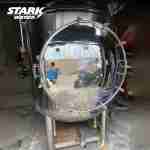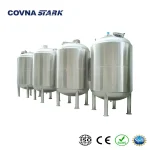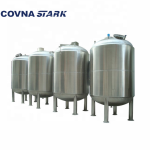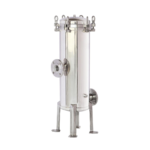Selecting the right water tank for industrial use is more than just choosing a storage capacity. It’s about ensuring operational safety, optimizing performance, and reducing long-term maintenance costs. With a variety of materials and configurations available—such as SUS316 stainless steel, duplex stainless steel, and FRP composite—it’s important to match the tank design to your site's specific water quality, chemical exposure, and pressure requirements.
This guide helps you understand the key differences between tank materials and configurations so you can confidently choose a solution that meets your operational and compliance goals. Whether you operate a food processing plant, a chemical treatment facility, or a municipal water station, the right tank will protect your water quality—and your bottom line.
Key Factors When Choosing a Water Tank for Industrial Use
When selecting a water tank for industrial environments, it’s essential to look beyond basic storage volume. Factors such as water chemistry, temperature variation, pressure rating, space constraints, and maintenance needs all influence which tank material and design will perform best. Here are the most critical factors to consider:
1. Water Composition & Corrosiveness
The type of water stored—whether it's chlorinated, deionized, saline, or chemically dosed—will directly affect the material compatibility. Duplex stainless steel offers superior resistance to chloride stress corrosion cracking, while SUS316L is suitable for pure and mildly aggressive waters. For neutral pH storage without chemical exposure, FRP tanks may suffice.
2. Operating Pressure and Temperature
Industrial tanks often operate under varying pressures and thermal conditions. Duplex steel has a much higher yield strength than standard stainless steel, making it better for high-pressure loops, RO systems, or hot process water. FRP tanks have limited pressure resistance and can deform at elevated temperatures.
3. Hygiene & Cleanability
In food, pharmaceutical, and electronics applications, tanks must comply with sanitary requirements. SUS316L tanks offer excellent hygiene due to their polished interiors and compatibility with CIP (Clean-in-Place) systems. Duplex tanks can also be polished to sanitary finish and used where higher mechanical strength is needed with hygienic design.
4. Location: Indoor vs Outdoor
Tanks installed in coastal or outdoor environments face greater UV, humidity, and salt exposure. Duplex steel outperforms both SUS316L and FRP in coastal and high-salinity settings. FRP tanks may become brittle and discolored over time if not shielded properly.
5. Lifecycle Cost (TCO)
Initial cost isn’t the only metric that matters. Consider cleaning frequency, repair likelihood, downtime risk, and replacement cycle. Although duplex and SUS316 tanks have higher upfront costs than FRP, their extended service life and lower maintenance make them a more economical choice over time.
Comparing Tank Materials: SUS316 vs Duplex vs FRP
Choosing the right tank material means balancing corrosion resistance, mechanical strength, hygiene, and cost. Here’s a direct comparison between SUS316 stainless steel, duplex stainless steel, and FRP (fiberglass-reinforced plastic) tanks:
| Material | Corrosion Resistance | Mechanical Strength | Hygiene Level | Temperature/Pressure Tolerance | Typical Applications | Estimated Lifespan |
|---|---|---|---|---|---|---|
| SUS316 Stainless Steel | Excellent (for clean/pure water) | Moderate | High (CIP compatible, sanitary finish) | Up to 100°C / 0.6 MPa | Food, Pharma, Electronics | 15–20 years |
| Duplex Stainless Steel (2205) | Outstanding (for saline, chlorinated, and aggressive media) | High (2× strength of 316) | High (sanitary finish available) | Up to 120°C / 1.0 MPa | Marine, Chemical, Municipal, RO | 20–25 years |
| FRP (Fiberglass Composite) | Moderate (requires coating for chemical use) | Low to Moderate | Low (difficult to clean, porous surface) | Up to 60°C / 0.3 MPa | General water storage, rainwater, non-critical process | 8–12 years |
While FRP tanks may offer a lower initial cost, their limitations in chemical compatibility, hygiene, and mechanical performance make them unsuitable for demanding industrial or regulated environments. Duplex and SUS316 tanks, while more costly upfront, deliver long-term durability and safety in both static and high-pressure systems.
Which Type Fits Your Application?
The choice of tank material should be based on your specific operating conditions, including water chemistry, sanitation requirements, pressure levels, and budget. Use the table below to match the right material with your application—and explore the STARK tank options that fit your needs.
| Application Scenario | Recommended Material | STARK Product Link |
|---|---|---|
| Chlorinated drinking water or RO permeate | SUS316 Stainless Steel |
1500L SUS316 Sterile Tank |
| Brackish, seawater, or chemically aggressive liquids | Duplex Stainless Steel (e.g., 2205) |
Duplex Stainless Steel Tank |
| Non-critical general-purpose storage (rainwater, cooling) | FRP Composite Tank |
Premium FRP Composite Tank |
Not sure which option fits your system best? Our engineering team at STARK can help you assess chemical compatibility, insulation needs, and compliance requirements for your next project.
Contact us today for custom support.
Conclusion: The Right Tank Saves More Than Water
Choosing the right stainless steel water tank is a critical decision that impacts water quality, operational safety, and long-term cost-efficiency. While FRP tanks may work for basic storage, industrial applications often demand the enhanced strength, chemical resistance, and hygiene standards offered by SUS316 and duplex stainless steel.
At STARK, we provide a full range of industrial-grade water storage solutions—including duplex steel tanks for aggressive water environments, SUS316 sterile tanks for sanitary systems, and FRP composite tanks for economical storage needs.
Need help selecting the best tank for your project? Contact the STARK team today for technical support, customization options, and quotation.
Further Reading & Technical References
To learn more about stainless steel water tanks, material selection, and international standards, we recommend the following authoritative resources:
-
Wikipedia – Stainless Steel Overview
A general introduction to stainless steel, its structure, and corrosion properties. -
Nickel Institute – Practical Guide to Using Duplex Stainless Steels
Comprehensive guide on the properties, applications, and advantages of duplex stainless steels. -
Nickel Institute – Fabricating Stainless Steels for the Water Industry
Guidelines for achieving top performance when fabricating stainless steels for water industry applications. -
Nickel Institute – Stainless Steel for Potable Water Treatment Plants
Insights into the use of stainless steel in potable water treatment applications. -
CDC – About Safe Water Storage
Guidelines and best practices for safe water storage to prevent contamination. -
Engineering Toolbox – Stainless Steel Classifications
Detailed classifications and properties of various stainless steel types.





